PITTSBURGH - When it comes to treating lumbar spinal stenosis in the lower back area, physical therapy can be as effective as surgery, a University of Pittsburgh study has found.
And it might be the best option to try first. That was Dale Urban’s thinking at age 78.
The Pittsburgh-area resident said pain progressively worsens whenever he walks 50 to 100 yards or does dishes.
“Toward the bottom end of the spinal area is where I feel increasing pain that goes from zero to 100,” he said. “I feel the intensity rising. I sit down and the pain goes away.”
His physical therapy includes riding a stationary bicycle, physical manipulation of his lower spine and assigned exercises he does at home.
“The first experience is, you get relief from the treatment, but it’s temporary relief right now,” Urban said, after four of 12 sessions. “I’m hoping for long-term relief after I undergo all the treatments and modulations.”
The University of Pittsburgh study, published online in the Annals of Internal Medicine, found nearly equal success between physical therapy and decompression surgery for lumbar spinal stenosis, a degenerative condition that commonly occurs as people age.
Narrowing of the spinal canal in the lumbar region from age, arthritis or many other factors can compress the spinal cord or the nerve roots exiting the spine to form large nerves. Resulting compression of these nerves can cause pain, numbness and weakness in the lower back, buttocks, thighs and legs. Decompression surgery is now the fastest-growing intervention in the older population.
“Although proportions of successes were similar” between those who had surgery versus physical therapy, “there also were similar proportions of patients (in each group) who did not achieve a clinically meaningful level of improvement,” the study said.
Further study would be necessary to determine why people respond differently to treatments.
All 169 participants in the study were diagnosed via magnetic resonance imaging (MRI) and existence of pain from walking, as happened to Urban. Such pain typically disappears once the person sits down.
“The first thing people should strongly consider is exhausting all non-surgical options. Surgery should be the last resort,” said Anthony Delitto, study leader and chairman of Pitt’s Department of Physical Therapy. “The study shows that people don’t exhaust nonsurgical options. Physical therapy is one option and based on the study, it’s a good option, and people should consent to that before surgery. Even if you decide on surgery, it should be a shared decision with the surgeon with full knowledge of the expectations of success.”
Of the 169 participants, 87 were randomly assigned to have surgery and 82 to have physical therapy. In the first group, 74 patients underwent surgery, with 45 showing success after two years (a 61 percent success rate). Another 44 patients were assigned to receive physical therapy, but opted instead to have surgery, with 24 having success (or 55 percent). Of the other 29 patients who completed physical therapy, 15 had long-term relief (52 percent). There were no gender differences in the results, the study says.
A reason some quit therapy in favor of surgery, Delitto said, were the health-insurance copays, which ranged from $20 to $50 for each therapy session. Insurance tended to cover all costs of surgery, including copays.
But Delitto, a physical therapist with a Ph.D., said the total cost of 12 rounds of physical therapy was $1,440, including almost $300 in out-of-pocket expenses and copays. The cost of decompression surgery is $24,000. More people likely would opt for more cost-effective therapy if Medicare and other health insurance companies eliminated copays.
“We need to remove barriers to more cost-effective solutions,” Delitto said.
“At the very least, someone should try physical therapy before consenting to surgery. With a study like this, payers might reduce the copay or eliminate it,” at least for a minimum number of therapy sessions.
Richard A. Deyo, professor of family medicine at Oregon Health and Science University, said the Pitt study is interesting and important, especially given its well-organized, structured approach to providing physical therapy.
He said the study shows therapy to be “a reasonable choice for patients” with spinal stenosis.
“It’s fair to say that the surgical approach is often helpful for symptom relief, but you must realize it’s not a permanent cure for some people,” Dr. Deyo said. “Some have to undergo surgery again” with increasing risks.
About the Author
Keep Reading
The Latest
Featured


